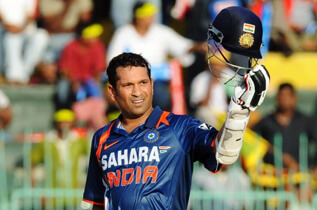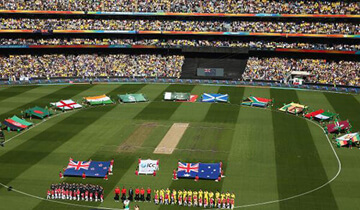Cricket is a bat-and-ball team sport played between two teams of 11 players each. Cricket originated in England and is now one of the most popular sports in the world.
The game is played on a cricket field with a 22-yard long pitch at the center. Each team takes turns to bat and bowl (pitch). The batting team tries to score runs by hitting the ball and running between the wickets, while the bowling team tries to get the batsmen out. When 10 batsmen are out, the innings is over and teams switch roles. The team with the most runs wins.
Cricket was first played in southern England in the 16th century. By the 18th century, it had developed into a national sport. English colonies spread cricket to regions like the West Indies, India, Australia and South Africa. Today, there are over 100 cricket-playing countries. Cricket is most popular in the Commonwealth nations.
Cricket Formats:
There are three formats of cricket matches:
Test Cricket
- Played over 5 days with 90 overs per day
- Considered cricket’s supreme test
- International test matches are played between national teams
One Day Cricket
- Played over 1 day with 50 overs per team
- Fast-paced and entertaining
- International matches are called One Day Internationals (ODIs)
Twenty20 Cricket
- Played over 3 hours with 20 overs per team
- Fastest format focused on big hitting
- Premier Twenty20 leagues like IPL exist with city-based teams
History and Origin of Cricket
Tracing cricket’s origins to 13th century England as a rural game
Cricket traces its origins to 13th century England where it emerged as a rural pastime. The first known reference to the sport comes from a court case in Guildford in 1597 which mentions the existence of a “creckett” being played by boys at the Royal Grammar School. By the end of the 16th century, cricket had evolved into a more organized adult activity played in villages across southern England.
The name “cricket” likely derives from the Middle Dutch word “krickstoel” meaning a long low stool. This refers to the early use of a tree stump or the equivalent as a primitive wicket. The game involved two teams where batsmen defended the wicket from balls delivered by the opposing team’s bowler, similar to the basic aspects of modern cricket.
The development of early forms of cricket with tree stumps/sheep gates as wickets
In its early years, cricket matches had very rudimentary equipment. The “wicket” typically consisted of a tree stump or the gate of a sheep pen. The ball was simply made of rags or wool, wrapped tightly together. The bat evolved from a wooden club to a paddle-shaped piece of willow wood.
With improvised equipment, cricket was primarily played on country commons, roads, heaths and churchyards in southern England during the 17th century. Teams represented and were funded by nearby villages and households. Gambling on matches became common, indicating cricket’s rising popularity.
Emergence of early rules and techniques in 16th-18th centuries
As cricket grew beyond its village roots, the need for standardized rules increased. The 1727 Articles of Agreement for Tom Faulkner’s XI vs Edwin Stead’s XI first documented basic rules on team size (11 players per side), the bowling crease, the size of the pitch and the length of the bat.
Bowling techniques evolved from slow underarm lobs to faster overarm deliveries. Batsmen introduced innovations like forward defensive shots. Fielding positions became more defined. By the mid-1700s, cricket began to resemble the modern game.
Spread of cricket’s popularity from southern England to London
Cricket’s popularity started expanding beyond southern England in the early 18th century. In 1709, the first recorded inter-county match took place between Surrey and Kent. The opening of Lord’s Cricket Ground in 1787 underscored the growing appeal of cricket in London.
The establishment of the original Hambledon Club in Hampshire in the 1760s instituted further advancements, including wider bats, the three-stump wicket and limits on fielders. Cricket’s popularity made it a gambling focal point, necessitating expert players.
Establishment of the Marylebone Cricket Club and codification of rules
The Marylebone Cricket Club (MCC) was founded in 1787 based on the original White Conduit Club. The MCC took stewardship of the rules and became the accepted legislative body on laws of cricket.
Key MCC rule changes included the overarm bowling legalization in 1864, protecting batters’ legs, boundaries, declaration of innings closed, wide balls, and more. MCC rules helped standardize cricket and paved the way for international competition.
The inaugural Test match between England and Australia in 1877
The first official international Test match took place between Australia and England in Melbourne in 1877, representing a major milestone. Australia won the low-scoring affair by 45 runs, proving competitive against the founders of cricket and marking the beginnings of the Ashes rivalry.
W.G. Grace scored 152 for England as the team won a classic second Test. The early Ashes Tests featured four-ball overs, no limits on leg side wides, underarm bowling, and wickets uncovered during rain. But the competitiveness and excitement demonstrated cricket’s viability as an international sport.
International Growth
The spread of cricket from England to British colonies and the growth of international competition
Cricket originated in England in the 16th century and soon spread to British colonies around the world. By the 18th century, cricket was being played in North America, the Caribbean, India, Australia and New Zealand. As the game took root in these countries, localized variants and playing styles emerged. International competition began in the 19th century with England touring North America in 1859 and Australia in 1861. The growth of the British Empire helped cricket spread globally and led to the first Test matches between England and Australia in 1877. International tours became more frequent over the next decades. The Ashes between England and Australia became a celebrated rivalry, capturing public imagination. Cricket’s growth was aided by improved transportation links and communication technologies.
The founding of Australia, West Indies, India, Pakistan teams and their successes
In the 20th century, former British colonies developed strong domestic structures and founded national cricket teams. Australia was represented by a united national team from 1912, the West Indies from 1928. South Asian teams - India, Pakistan, Sri Lanka - joined in the 1930s. These teams gained Test status and notched up major wins against England. The 1948Invincibles from Australia toured England undefeated. The West Indies emerged as a dominant force in the 1970s-80s under Clive Lloyd. India found stars like SunilGavaskar, KapilDev and SachinTendulkar. Pakistan produced the feared pace duo of WasimAkram and WaqarYounis. Cricket became a source of national pride and an outlet for assertion by these post-colonial nations.
Cricket becoming a unifying force for South Asian nations after independence
After the Partition and independence in 1947, cricket played a pivotal role in bringing the estranged nations of India and Pakistan together. Despite war and conflict, cross-border cricket ties have remained intact. Players and fans from both countries passionately follow cricketing contests between the arch-rivals. The India-Pakistan cricket rivalry is one of the fiercest in sport. But cricket is also a reminder that Indians and Pakistanis share a common cultural heritage and history. For communities divided by geopolitics, cricket becomes a unifying force transcending boundaries. The game is a vehicle for goodwill and cultural diplomacy in South Asia.
The expansion of cricket’s reach and development across continents
From its colonial strongholds, cricket expanded to diverse regions like East Asia, Africa and Europe. South Africa returned to international cricket after Apartheid. Zimbabwe and Kenya emerged as competitive teams in the 1990s.The ICC expanded its membership to over 100 countries by the 21st century. UAE and Afghanistan gained prominence as neutral venues and competitive teams. The T20 format accelerated cricket’s spread as an accessible, fast-paced game. Domestic T20 leagues like IPL, BBL, CPL have attracted top talent from across the cricketing world and boosted the sport’s following globally. Women’s cricket has also made huge strides with World Cups and growing viewership. The geographical reach of cricket is wider today than ever before.
Cricket Formats
Test Matches
Test matches are the longest form of cricket, played over 5 days with each team batting twice. Test cricket has been played since 1877 and is considered the most prestigious format. Teams have unlimited overs to play, the only limit is the time. Draws are a common result. Test matches allow players to showcase patience, concentration, stamina and advanced cricket skills over an extended period. Strategies focus on wearing down the bowling attack and batting for long periods to build up a huge score.
One Day Matches
One Day International (ODI) matches last around 8 hours, with each team batting for a single innings of 50 overs. ODI cricket began in 1971 and shortened the game considerably compared to Tests. The 50 over limit forces teams to score runs more quickly. ODIs often produce results as teams are all out rather than drawing based on time. Tactics focus aggressively on scoring runs, with more risk-taking shots common. Bowling strategies aim for quick wickets to restrict the opponent’s score. ODIs also introduced fielding restrictions and colored uniforms.
Twenty20
Twenty20 is the shortest format, introduced in 2003. Each team bats for just 20 overs, lasting around 3 hours. T20 emphasizes explosive batting, high scoring and big hitting. Defense is minimized as risks are taken to score quick runs before getting out. Bowlers focus on containment and taking wickets. The fast-paced nature makes T20 popular with crowds. Major T20 leagues like the IPL have dramatically increased its popularity. However, some criticize it reduces cricket skills to simple power hitting.
Prominence of Formats
Test cricket is most prominent in England, Australia and South Asia. Tests were traditionally the pinnacle of cricket but their popularity has declined. ODIs gained prominence in the 1970s and 80s, becoming the focus of international cricket. The Cricket World Cup is played in ODI format. T20 has grown rapidly since the 2000s, attracting new fans. All major cricketing nations now have T20 leagues. However Test cricket still retains prestige, particularly the Ashes between England and Australia. Debates continue about adjusting rules to keep forms relevant.
Rules and Gameplay
Basic Rules
Cricket is played between two teams of 11 players each on a large oval-shaped field. The objective is to score more runs than the opposing team. Teams bat in successive innings and attempt to score runs while the opposing team fields. Each team bats until 10 of their 11 batters are ‘out’, after which the teams switch roles for the next innings.
Batting, Bowling and Fielding
In cricket, two batters are on the field at a time. A designated player from the fielding team called the bowler delivers the ball to the batter who attempts to hit the ball. The batter can score runs by hitting the ball and running between the wickets located at each end of the pitch. The fielding team aims to prevent runs being scored and get batters out.
Scoring Runs
The main ways runs are scored are when batters run between wickets, hit boundary 4s or 6s, are awarded extras such as byes, or when penalties like no-balls are awarded. Runs are accumulated over innings and the team with the most runs wins.
Dismissing Batters
A batter is out when they are caught, bowled, run out, stumped, or leg before wicket (LBW). Once 10 batters are out, the innings ends. The objective of the fielding team is to dismiss batters through catches, run outs, stumpings and LBWs.
Cricket Field and Equipment
The cricket field is a large oval with a rectangular 22-yard long pitch in the center. Boundaries are marked with ropes. Key features are the wickets, creases, close-in fielding positions like slips and covers. Equipment includes a leather ball, wooden bats and protective gear.
Laws of Cricket
The Marylebone Cricket Club (MCC) maintains the Laws governing cricket. Key laws deal with overs, runs, wides, no-balls, byes, leg byes, the follow-on, substitution of players, equipment specifications, dismissing batters and rules for rain interrupted matches. The laws ensure fair play.
Overs, Wides and No Balls
An over consists of 6 legal deliveries from a bowler. A wide ball is too far from the batter to hit. A no ball is an illegal delivery, usually overstepping the crease. Wides and no balls score 1 run plus any other runs scored off them and an extra delivery must be bowled.
Byes and Leg Byes
Byes are runs scored when a batter misses the ball and the wicketkeeper fails to stop it. Leg byes are scored if the ball hits the batter’s body and they run. Neither count against the bowler but are credited to the team’s total runs.
This covers the basic gameplay, rules, equipment, field, scoring and laws governing cricket. The complex game has simple origins but has evolved over centuries into the intricate sport enjoyed globally today. The framework allows strategy and skills to determine the outcome.
Strategy and Technique
Tactics for batting, bowling, field placement and their variations
Cricket is a sport that requires strategic thinking and adaptability. Teams need to constantly adjust their tactics and techniques based on the match situation.
Batting Tactics
Batting tactics depend on factors like the format of the game, pitch conditions, target score, and current match situation. Tactics can vary from aggressive hitting to patient accumulation of runs. Opening batsmen look to see off the new ball and give a good start. The middle order consolidates during the middle overs before going for big shots later. Tactics also vary between batsmen with different skills and roles - pinch hitters, accumulators, finishers etc.
Bowling Tactics
Bowling tactics involve the choice of bowlers, line and length, use of variations, and field settings. During the initial overs, the aim is to restrict runs and take early wickets with pace bowling and swinging conditions. In the middle overs, spinners come into play on dry pitches. Reverse swing, cutters, slower balls can be used as variations for wicket-taking. Field settings are attacking for a wicket-taking bowler and defensive for a containment bowler.
Fielding Tactics
The captain and bowler together decide the appropriate field placement based on the match situation. Attacking fields include multiple slips and close-in fielders to take catches. Defensive fields spread the field to save runs. Other fielding tactics include packed offside field, leg-side field, and split fields between sides of the wicket.
Specialized roles of batsmen, bowlers, wicket-keeper and captain
Cricket teams are made up of players with specialized skillsets and roles.
Batsmen
Specialized batting roles include openers, middle order anchors, power hitters, finishers etc. Openers face the new ball and lay a solid foundation. The middle order must consolidate during middle overs and accelerate later. Finishers play aggressive knocks under pressure to chase down or post big targets.
Bowlers
Bowling attacks require different types of bowlers. Fast bowlers rely on pace and swing. Spinners provide control through spin and variation. Specialist roles like strike bowler, death bowler, and containment bowler are assigned based on skills.
Wicket-keeper
The wicket-keeper plays the specialized role of taking catches and stumpings. A good keeper can turn games with their skills. Their input on field settings is also crucial.
Captain
The captain marshals all the resources at their disposal. They set fields, decide bowling changes, and lead the team’s strategy and intensity. The captain’s tactical decisions can make or break the team’s fortunes.
Importance of adjusting techniques and strategy between formats
Cricket has three major formats - Tests, ODIs, and T20s. Each format requires specific technical skills and strategic thinking. Players have to adapt their techniques and game plans based on the format.
Tests require immense patience, solid techniques and ability to excel over 5 days. ODIs need skills to score at a higher strike rate in a full 100 over game. T20s demand aggressive batting, variations in bowling, and ability to absorb pressure in a short intense format. Teams analyze opponents and conditions to formulate distinct strategies optimized for each format.
The best players adjust their shot selection, footwork, bowling variations, and match approach effectively between formats. Teams need to select the right mix of players with techniques suited for the format. Getting this balance right is the hallmark of a successful cricket team.
Use of advanced analytics and technology for strategy
Cricket has seen increasing use of data analytics to improve strategy and performance. Analytics provides insights using statistics, video analysis, simulation models, predictive analysis etc.
Tools like Hawkeye, performance trackers, and wearables generate volumes of data. These are analyzed to find patterns, insights and strategic recommendations on areas like selection, training, technique and match strategy.
Big data analytics combined with human expertise allows teams to pursue data-driven decision making. It helps teams counter weaknesses and play to their strengths. Adopting analytics has become crucial for cricket teams to gain a strategic edge over opponents.
Popularity and Impact
Cricket as a major sport
Cricket is one of the most popular sports in the world with a huge and passionate fan base. It is the national sport of England, Australia, India, Pakistan, Bangladesh, Sri Lanka, South Africa and many other Commonwealth nations. The pinnacle of the sport, test cricket, sees matches last up to 5 days and crowds fill cavernous stadiums for this slow-burning contest of skills. Cricket has successfully transitioned to the shorter one-day and T20 formats that have attracted new audiences. Top cricket events like the ICC World Cup or the IPL can have viewership running into billions.
Cricket has become a lucrative sport for players, teams, leagues and broadcasters. Star cricketers are among the highest earning athletes globally thanks to multimillion dollar contracts with national teams, clubs and endorsement deals. Media rights for major cricket events and leagues are sold for billions of dollars. Top teams earn massive revenues from ticket sales, sponsorships and merchandising. The Board of Control for Cricket in India (BCCI) is the richest cricketing body in the world.
Influence of star cricketers
Cricketers have huge followings and wield significant cultural influence, especially in cricket-crazy nations like India, Pakistan and the West Indies. Star cricketers like Sachin Tendulkar, Virat Kohli, Imran Khan and Brian Lara are revered as national heroes. Their cricketing exploits and personal lives are keenly followed by fans. They endorse major consumer brands and lend their star power to social causes. Former players also move into coaching, administration and broadcasting roles post retirement.
For many young fans, star cricketers also serve as inspirational role models to emulate. Youngsters idolize their cricketing idols and aspire to follow in their footsteps. The youth look up to cricketers for their sporting success as well as their off-field conduct and contributions to society.
Cricket as cultural glue
Cricket has served as an important cultural bond for diverse cultures across South Asia and the West Indies. The former British colonies developed a shared passion for cricket during the colonial era. Post independence, cricket has united fans across borders, acting as an important cultural glue. Intense cricketing rivalries between the South Asian nations co-exist with solidarity.
In racially diverse Caribbean nations, cricket has been similarly unifying, cutting across ethnic and class divisions. Cricket icons like Garfield Sobers and Viv Richards have been sources of immense pride and identity. The sport is closely tied with a sense of national belonging.
Global expansion
In recent decades, cricket has sought to expand beyond the Commonwealth realm where it has traditionally thrived. Cricket administrators have targeted untapped markets like China, USA, and Europe to broaden the sport’s appeal and revenue bases.
The International Cricket Council expanded its global events to include more non-Commonwealth teams like Afghanistan and Ireland. Domestic T20 leagues like the IPL, BBL and CPL now recruit players from associate nations. USA, Canada and the UAE have hosted major cricket events to reach new audiences.
However, cricket’s growth in non-traditional strongholds remains slow. The sport faces stiff competition from football, basketball, baseball and other sports with deeper roots in these countries. Breaking into these sporting cultures will require long-term investment and grassroots development.
Conclusion
Cricket began as a rural English pastime but evolved into a global sport over centuries. Its spread was enabled by the growth of the British Empire and it took firm root in the Commonwealth. Though originating in England, cricket today thrives most vibrantly in the former colonies of South Asia and the West Indies. The different formats of Tests, ODIs and T20s have allowed cricket to adapt with the times and expand its audience and revenue. Key to cricket’s popularity across diverse cultures has been its ability to unify people across boundaries and identities. From tense but unifying rivalries between neighboring nations, to providing a sense of belonging within multi-ethnic societies, cricket’s linkages with postcolonial national identities have ensured its enduring appeal. However, for cricket to keep growing globally, administrators must invest in developing the sport beyond its traditional bastions through youth engagement and infrastructure development. If they can successfully achieve this, cricket has the potential to become a truly global game like football and basketball in the coming decades.







































